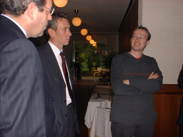DESIGNING CONCEPTS FOR STYLES AND ROLES
Leadership styles
Developing a ‘leadership style language’ is not very difficult.
There is an abundance of literature and numerous theories about leadership. However to create a language that allows us to speak freely about the preferred style of a leader, LDpe used some additional requirements:
- The language must be defined with a limited number of words, to indicate different leadership styles;
- The words of this language need to belong to the leadership domain rather than that of the psychologists and be self explanatory;
- The ‘words’ of the ‘leadership style language’ must have a positive emotional value, and free from stigmatisation;
- The ‘words’ of the ‘leadership style language’ need to reflect the relation between the leader and his environment (employees, colleagues, superiors, organisation, profession, etc.);
The LDT-vocabulary refers to most of the accepted existing leadership style models, from Blake & Mouton’s managerial grid, through Reddin’s 3-D theory and Hersey and Blanchard’s situational leadership model. It addresses three important dimensions: a focus on the managerial role, a focus on people interaction and on dealing with the development of the organisation.
Worker styles
LDpe faced a more difficult problem in 2003 when we wished to define workers styles in analogy with these leadership styles. It is surprising, even astonishing, that there is hardly any literature available on this subject. The worker style concepts were designed and defined by a natural working team, with participants from the HR and LD discipline, program- and project leaders and leading professionals.
Professional Roles
In the domain that LDpe in the toolbox describes as ‘professional roles’, there is a large amount of different local and method based definitions. But, unlike the domain of leadership, it is almost impossible to unify the different concepts. Therefore it was decided to use the experiences in LDpe’s own practice and, in dialogue with professionals in the field, define the concepts and models that were developed for the toolbox. These concepts and models structure the fields of client relation development, commercial roles and program- and change management and they enable participants to specify their strengths and development area’s in these fields.






